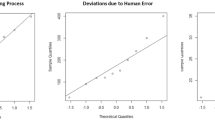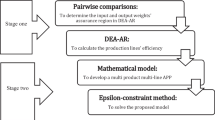Abstract
This research evaluates the efficiency of blistering lines over a 2-year period starting January 2013 till December 2014 using data envelopment analysis models. The planned production quantity in units, defect quantity in units, and idle time in units are selected as inputs. The actual produced quantity in units is the output measure. The data are then normalized using the min–max normalization. Six windows are formed, and then the technical, pure technical, and scale efficiency are calculated for three identical blistering machines lines, BL1, BL2, and BL3, in each year. Results showed significant reductions in technical (TIE), pure technical (PTIE) inefficiency, and scale inefficiency (SIE) scores in year 2014. For BL1, the average TIE, PTIE, and SIE are reduced from 0.1152 to 0.0477, 0.0751 to 0.0176, and 0.0429 to 0.0304, respectively. For BL2, the average TIE, PTIE, SIE are reduced from 0.0968 to 0.0282, 0.0514 to 0.0133, and 0.0486 to 0.0149, respectively. Finally, for BL3, the average TIE, PTIE, SIE are reduced from 0.0936 to 0.0527, 0.0396 to 0.0154, and 0.0556 to 0.0380, respectively. In practice, the sources of TIE are mainly failure to operate at most productive scale size (SIE) and/or the poor input utilization (PTIE). In conclusion, the research results provide valuable feedback on how to improve efficiency, utilize resources, and effectively manage production lines.


Similar content being viewed by others
Explore related subjects
Discover the latest articles and news from researchers in related subjects, suggested using machine learning.References
Charnes A, Cooper WW, Rhodes E (1978) Measuring the efficiency of decision making units. Eur J Oper Res 2(6):429–444
Al-Refaie A, Najdawi R, Sy E (2016) Using DEA window analysis to measure the efficiencies of blowing machines in plastics industry. Jordan J Mech Ind Eng 10:27–38
Seiford LM, Thrall RM (1990) Recent developments in DEA: the mathematical programming approach to frontier analysis. J Econom 46(1–2):7–38
Chen CJ, Lin BW, Wu HL (2006) Evaluating the development of high-tech industries: Taiwan’s science park. Technol Forecast Soc Change 73(4):452–465
Li MH, Al-Refaie A, Jarbo M, Yeh CH (2014) IDEA approach for solving multi-responses fuzziness problem in robust design. J Qual 21(6):455–479
Al-Refaie A (2014) Optimizing performance with multiple responses using cross-evaluation and aggressive formulation in data envelopment analysis. IIE Trans 44(4):262–276
Al-Refaie A, Fouad R, Li MH, Shurrab M (2014) Applying simulation and DEA to improve performance of emergency department in a Jordanian hospital. Simul Model Pract Theory 41(2):59–72
Al-Refaie A (2009) Optimizing SMT performance using comparisons of efficiency between different systems technique in DEA. IEEE Trans Electron Packag Manuf 32(4):256–264
Yang HH, Chang CY (2009) Using DEA window analysis to measure efficiencies of Taiwan’s integrated telecommunication firms. Telecommun Policy 33(1–2):98–108
Halkos GE, Tzeremes NG (2009) Exploring the existence of Kuznets curve in countries’ environmental efficiency using DEA window analysis. Ecol Econ 68(7):2168–2176
Zhang XP, Cheng XM, Gao XJ (2011) Total-factor energy efficiency in developing countries. Energy Policy 39(2):644–650
Charnes A, Cooper WW, Seiford LM (1994) Extension to DEA Models. In: Charnes A, Cooper WW, Lewin AY, Seiford LM (eds) Data envelopment analysis: theory, methodology and applications. Kluwer, Dordrecht
Hemmasi A, Talaeipour M, Khademi-Eslam H, Farzipoor R, Pourmousab SH (2011) Using DEA window analysis for performance evaluation of Iranian wood panels industry. Afr J Agric Res 6(7):1802–1806
Yang C (2014) An enhanced DEA model for decomposition of technical efficiency in banking. Ann Oper Res 214:167–185. https://doi.org/10.1007/s10479-011-0926-z
Řepková I (2014) Efficiency of the Czech banking sector employing the DEA window analysis approach. Proced Econ Finance 12:587–596
Tavana M, Khalili-Damghani K, Rahmatian R (2015) A hybrid fuzzy MCDM method for measuring the performance of publicly held pharmaceutical companies. Ann Oper Res 226(1):589–621
Al-Refaie A, Hammad M, Li MH (2016) DEA window analysis and Malmquist index to assess energy efficiency and productivity in Jordanian industrial sector. Energy Effic 9(6):1299–1313
Banerjee A (2017) An empirical study to measure the efficiency of indian pharmaceutical companies during recession period utilizing data envelopment analysis. Res Bull 43(2):1–13
Gascón F, Lozano J, Ponte B, Fuente D (2017) Measuring the efficiency of large pharmaceutical companies: an industry analysis. Eur J Health 18(5):568–587. https://doi.org/10.1007/s10198-016-0812-3
Rentala S, Anand B, Shaban M (2017) Institutional reforms and export efficiency of Indian pharmaceutical industry—a comparative analysis of transitory-TRIPS and post-TRIPS periods. TSM Bus Rev 5(1):34–51
Cooper WW, Seiford LM, Zhu J (2004) Data envelopment analysis: History, models and interpretations. In: Cooper LM, Seiford LM, Zhu J (eds) Handbook on data envelopment analysis. Kluwer, Boston, pp 1–39
Banker RD, Charnes A, Cooper WW (1984) Some models for estimating technical and scale inefficiencies in data envelopment analysis. Manage Sci 30(9):1078–1092
Al-Refaie A (2010) Super-efficiency DEA approach for optimizing multiple quality characteristics in parameter design. Int J Artif Life Res 1(2):58–71
Al-Refaie A (2011) Optimising correlated QCHs in robust design using principal components analysis and DEA techniques. Product Plan Control 22(7):676–689
Ma J, Evan DG, Fuller RJ, Stewart DF (2002) Technical efficiency and productivity change of China’s iron and steel industry. Prod Econ 76(3):293–312
Pulina M, Detotto C, Paba A (2010) An investigation into the relationship between size and efficiency of the Italian hospitality sector: a window DEA approach. Eur J Oper Res 204(3):613–620
Shi GM, Bi J, Wang JN (2010) Chinese regional industrial energy efficiency evaluation based on a DEA model of fixing non-energy inputs. Energy Policy 38(10):6172–6179
Charnes A, Clark CT, Cooper WW, Golany B (1985) A development study of data envelopment analysis in measuring the efficiency of maintenance units in the US air forces. Ann Oper Res 2(1):95–112
Asmild M, Paradi JC, Aggarwall V, Schaffnit C (2004) Combining DEA window analysis with the Malmquist index approach in a study of the Canadian banking industry. J Prod Anal 21(1):67–89
Guller B, Yasar S (2010) Estimation of pinus brutia ten wood density from Fourier transform infrared (FTIR) spectroscopic bands by artificial neural network (ANN). Sci Res Essays 15(3):1765–1769
Cooper WW, Seiford LM, Tone K (2007) A comprehensive text with models, applications, references and DEA-solver software, 2nd edn. Springer, New York, p 327
Author information
Authors and Affiliations
Corresponding author
Ethics declarations
Conflict of interest
The authors declare that they have no conflict of interest.
Rights and permissions
About this article
Cite this article
Al-Refaie, A., Wu, CW. & Sawalheh, M. DEA window analysis for assessing efficiency of blistering process in a pharmaceutical industry. Neural Comput & Applic 31, 3703–3717 (2019). https://doi.org/10.1007/s00521-017-3303-2
Received:
Accepted:
Published:
Issue Date:
DOI: https://doi.org/10.1007/s00521-017-3303-2




